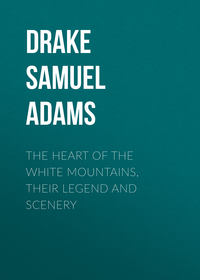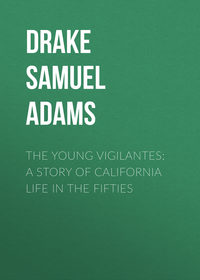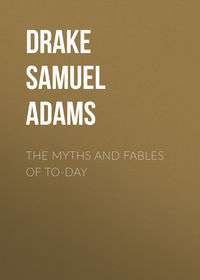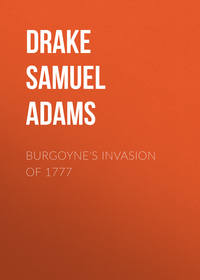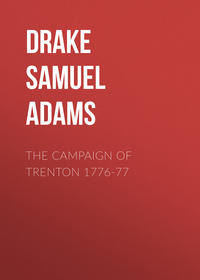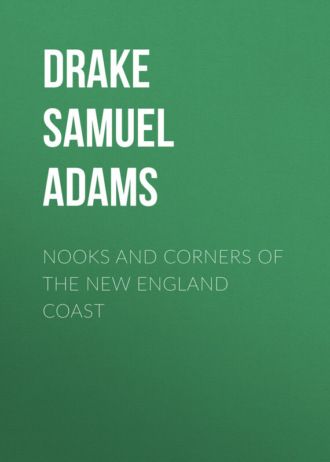 полная версия
полная версияNooks and Corners of the New England Coast
Mercy, the sister of James Otis, married James Warren, a native of Plymouth. He succeeded General Joseph Warren as president of the Provincial Congress of Massachusetts, but is better known as the author of the celebrated "Committee of Correspondence," which he proposed to Samuel Adams while the latter was at his house. Mrs. Warren, at the age of seventy, was visited by the Duke De Liancourt. "She then retained," he says, "the activity of mind which distinguished her as a sister of James Otis; nor had she lost the graces of person or conversational powers, which made her still a charming companion." For reasons apparent to the reader, she resolved not to send her "History of the Revolution" to the press during her husband's lifetime.
Going beyond the church, we come upon the open space of greensward, intersected by foot-paths, known as Cole's Hill. Some defensive works were erected on this bank in 1742, in the Revolution, and again in 1814. I have already traversed it in imagination, when standing on the summit of Burial Hill. It is no longer a place of graves, nor does it in the least suggest, by any monumental symbol, the tragedy of the Pilgrims' first winter here, when, as Bradford touchingly says, "Ye well were not in any measure sufficient to tend ye sicke; nor the living scarce able to burie the dead." Their greatest strait was in May and June, when there were no wild fowl. Winslow says they were without good tackle or seines to take the fish that swam so abundantly in the harbor and creeks.
We may not disguise the fact. The least attractive object is the Rock of the Forefathers. The stranger who comes prepared to do homage to the spot the Pilgrims' feet first pressed, finds his sensibility stricken in a vital place. The insignificant appearance of the rock itself, buried out of sight beneath a shrine made with hands, and the separation of the sacred ledge into two fragments, each of which claims a divided regard, give a death-blow to the emotions of awe and reverence with which he approaches this corner-stone of American history.
Plymouth Rock, or rather what is left of it in its original position, is reached by following Water Street, which, as its name indicates, skirts the shore, conducting you through a region once devoted to commerce, now apparently consigned to irretrievable decay. Near Hedge's Wharf, and in close vicinity to the old Town Dock, is the object of our present search. A canopy, designed by Billings, has been built above it. I entered. In the stone pavement is a cavity of perhaps two feet square, and underneath the uneven surface the rock appears. I had often wished to stand here, but now all enthusiasm was gone out of me. I had rather have contented myself with the small piece so long treasured, and with the loom of the rock as my imagination had beheld it, than to stand in the actual presence of it.
By the building of street and wharf on a higher level the rock is now at some little distance from high-water mark.193 At one time the sea had heaped the sand upon it to the depth of twenty feet, but the tradition of the spot had been well kept, and at the dawn of the Revolution the sand was cleared away, and the rock again laid bare. This was in 1774. In the attempt to remove it from its bed it split asunder, the superstitious seeing in this accidental fracture a presage of the division of the British empire in America. The upper half, or shell, of Forefathers' Rock was removed to the middle of the village, and placed at the end of a wall, where, along with vulgar stones, it propped the embankment. In 1834 the fractured half was removed from the town square to its present position in front of Pilgrim Hall, where it is now lying.
The honor of having first set foot on this threshold of fame is claimed for John Alden and Mary Chilton. The question of precedence will probably never be settled. It is also claimed for the exploring party who landed from the shallop on Monday, the 21st of December, commonly called Forefathers' Day.194
For more than two hundred years the 22d of December had been observed as the day of the landing; that is, in effect, to say, it had been so observed by the Pilgrims themselves, by their descendants around their firesides, and had received the sanction of formal commemoration, in 1769, by the Old Colony Club. Men were then living who were within two generations of the first comers, and retained all their traditions unimpaired. After this long period had elapsed, it was assumed that the Pilgrims had designed to signalize the landing of the exploring party of eighteen, rather than that from the Mayflower, and upon this theory, by adopting the new style, the landing was fixed for the 21st, a substitution which has been generally acquiesced in by recent writers. Unless it is believed that the landing of the party of discovery possessed greater significance to the Pilgrims, and to those who lived within hearing of the voices of the Mayflower, than the disembarkation of the whole body of colonists on the very strand they had finally adopted for their future home, the presumption of error in computing the difference between old and new style has little force.
For six weeks these explorations had continued all along the coast-line of Cape Cod, and nothing had been settled until the return of the last party to the ship. The Mayflower then sailed for Plymouth, and cast anchor in the harbor on the 16th; but the explorations continued, nor was there a decision until the 20th as to the best point for fixing the settlement. Moreover, there are no precise reasons for saying that the first exploring party landed anywhere within the limits of the present town of Plymouth, nor any tradition of its making the rock a stepping-stone.
We prefer to believe that the Pilgrims meant to illustrate the landing from the Mayflower– the event emphasized by poets, painters, and orators – as marking the true era of settlement; that the 22d of December was intelligently adopted by those best able to judge of their intentions; and that an unbroken custom of more than two centuries should remain undisturbed, even if it had originated in a technical error, which we do not believe was the case. "This rock," says the gifted De Tocqueville, "has become an object of veneration in the United States. I have seen bits of it carefully preserved in several towns of the Union. Does not this sufficiently show that all human power and greatness is in the soul of man? Here is a stone which the feet of a few outcasts pressed for an instant, and the stone becomes famous; it is treasured by a great nation; its very dust is shared as a relic. And what has become of the gate-ways of a thousand palaces? Who cares for them?"
The skeleton of a body was here before them, but, as Carlyle says, the soul was wanting until these men and women came. Mr. Sherley, writing to Bradford, says, "You are the people that must make a plantation and erect a city in those remote places when all others fail and return."
I do not find such conspicuous examples of intolerance among the Pilgrims as afterward existed in the Bay Colony. Lyford said they were Jesuits in their ecclesiastical polity, but they permitted him to gather a separate church and perform the Episcopal service among them. Beyond question, they were not willing to see the hierarchy from which they had fled establish itself in their midst. The intrigues of such men as Lyford within the colony, and Weston in the company at home, kept back the remnant of their own chosen associates, and re-enforced them with churchmen, or else men of no particular religion or helpfulness.
In November, 1621, the planters received an accession of thirty-five persons by the Fortune.195 It was the custom in the plantation for the governor to call all the able-bodied men together every day, and lead them to their work in the fields or elsewhere. On Christmas-day they were summoned as usual, but most of the new-comers excused themselves, saying it was against their consciences to work on that day. The governor told them if they made it a matter of conscience he would spare them until they were better informed. He then led away the rest. When those who had worked came home at noon they found the conscientious observers of the day in the street, at play; some pitching the bar, and some at stool-ball and like sports. The governor went to them, took away their implements, and told them it was against his conscience they should play while others worked. If they made keeping the day a matter of devotion, they must keep their houses, but there must be no gaming or reveling in the streets. Assuredly there was some fun in William Bradford, governor.
Hutchinson – after all the abuse of him, the fairest historian as to what transpired in advance of the Revolutionary period – gives the Plymouth colonists credit for moderation. When Mrs. Hutchinson was banished by Massachusetts, she and her adherents applied for and obtained leave to settle on Aquidneck, then acknowledged to be within the Plymouth patent. Before this, Roger Williams, who had been their minister, was, after his banishment from Salem, kindly used, though requested to remove beyond their limits, for fear of giving offense to the Massachusetts colony. Many Quakers probably saved their lives by fleeing to Plymouth, although the Pilgrims detested their worship and enacted laws against them. The town of Swanzey196 was almost wholly settled by Baptists.
The relations of the Pilgrims with the Indians were founded in right and justice, and stood on broader grounds than mere policy. This is shown in the unswerving attachment of Massasoit, the fidelity of Samoset, and the friendship of Squanto. The appearance of Samoset in the Pilgrim village was of good augury to the colony, and is worthy of a more appreciative pencil than has yet essayed it.
About the middle of March, after many false alarms of the savages, an Indian stalked into the town. Passing silently by the houses, he made straight for the rendezvous. I think I see the matrons and maids peeping through their lattices at the dusky intruder. He was tall, straight of limb, and comely, with long black hair streaming down his bare back, for, except a narrow girdle about his loins, he was stark naked. When he would have gone into the rendezvous the guard intercepted him. He was armed with a bow, and in his quiver were only two arrows, one headed, the other unheaded, as indicating the pacific nature of his mission. His bearing was frank and fearless, as became a sagamore. "Welcome, Englishmen," he said to the by-standers, astounded, as well they might be, on hearing such familiar salutation from the lips of a savage.
The first thing this Indian asked for was beer. The Pilgrims themselves preferred it to water, but they had none left; so they feasted him on good English cheer, and gave him strong waters to wash it down. His naked body excited astonishment, and a compassionate Pilgrim cast a horseman's cloak about him. Of all the assembly that encircled him, Samoset alone seemed unconcerned. The settlers had seen skulking savages on the hills, but they knew not what to make of this fellow, who thus dropped in on them, as it were, for a morning call. Since their first encounter with the Nauset Indians, they expected enmity, and not friendship. A midnight assault in their unprepared state was the thing most dreaded. Peace or war seemed to reside in the person of this Indian. They watched him narrowly. At night-fall they hoped he would take his leave; but he showed neither disposition to depart, nor distrust at beholding himself the evident object of mingled fear and suspicion. They concluded to send him on board the Mayflower for safe-keeping, and Samoset went willingly to the shallop; but it was low tide, and they could not reach the vessel. So they lodged him in Steven Hopkins's house. The next day he left them to go to Massasoit, and they finished by recognizing him as a friend, sent them by Heaven. Samoset was the Pemaquid chief, of whom we should gladly know more than we do. His communications were of importance to the Pilgrims, for Bradford admits that the exact description he gave them of his own country and of its resources was very profitable to them. I suppose it led to their establishing the trading-houses at Penobscot and Kennebec, and to the addition of the strip of country on the latter river to their patent of 1629, afterward enlarged by other tracts purchased of the Indians. The Pilgrims preferred trading to fishing, and no subsequent colony had such an opportunity to enrich themselves; but it was the policy of the English adventurers to keep them poor, and it may be questioned whether they developed the shrewdness in traffic for which their descendants have become renowned.
Samoset's coming paved the way for that of Massasoit, who made his entry into Plymouth with Indian pomp, in March. He was preceded by Samoset and Squanto,197 who informed the settlers that the king was close at hand. The Pilgrims were then assembled under arms on the top of Burial Hill, engaged in military exercise, and witnessed the approach of Massasoit with his savage retinue of sixty warriors. Here were two representative delegations of the Old World and the New; the English in steel caps and corslets, the Indians in wild beasts' skins, paint, and feathers. The bearing of the Christians was not more martial than that of the savages.
The Pilgrims stood on their dignity, and waited. At the king's request, Edward Winslow went out to hold parley with him. His shining armor delighted the Indian sachem, who would have bought it, together with his sword, on the spot, but Winslow was unwilling to part with either. After mutual salutations and some talk of King James, Massasoit, accompanied by twenty, proceeds to the town, leaving Winslow a hostage in the hands of Quadequina, his brother. At the town brook Massasoit is met by Standish with half a dozen musketeers. Here are more grave salutations, and then the king is conducted to an unfinished house, where the utmost state the Pilgrims could contrive was a green rug and three or four cushions placed on the floor. There is a roll of drum and blast of trumpet in the street, and Bradford, attended by musketeers, enters. He kisses the hand of the New England prince – "tho'," says Mourt, "the king looked greasily" – and the savage kisses Bradford. Then they sit. The governor calls for a stoup of strong waters, which he quaffs to the king, after the manner of chivalry; the royal savage drinks, in return, a great draught, that makes him "sweate all the time after."
"Give me the cups,And let the kettle to the trumpet speak,The trumpet to the cannoneer without,The cannons to the heavens, the heaven to earth.'Now the king drinks to Hamlet.' Come, begin."It may interest some readers to know what a real Indian king was like. "He was," says an eye-witness, "a very lustie man, in his best yeares, an able body, grave of countenance, and spare of speech; in his Attyre little or nothing differing from the rest of his followers, only in a great Chaine of white bone Beades about his necke; and at it behinde his necke hangs a little bagg of Tobacco, which he dranke and gave us to drinke; his face was painted with a sad red like murry, and oyled both head and face, that hee looked greasily. All his followers, likewise, were in their faces in whole or in part painted, some blacke, some red, some yellow, and some white, some with crosses, and other Antick workes, some had skins on them, and some naked, all strong, tall, all men in appearance.
"One thing I forgot; the king had in his bosome, hanging to a string, a great long knife. He marvelled much at our trumpet, and some of his men would sound it as well as they could." Mourt also states that the king trembled with fear while he sat by the governor, and that the savages showed such apprehension of the fire-arms that the governor caused them to be removed during the conference.
This was the first American Congress of which I have found mention. The Indians knew what a treaty of amity meant. They needed no instruction in international law. I believe they knew the Golden Rule, or had a strong inkling of it. That was a convention more famous than the Field of the Cloth of Gold, though there were but a green rug and a few cushions. "The peace," Bradford writes, "hath now (1645) continued this twenty-four years." "To which I may add," says Prince, "yea, 30 years longer, viz., to 1675."
The Indians, at the entertainment given them in Plymouth, partook heartily of the food set before them, but they could not be induced to taste spices or condiments. Salt was not used by them. Gosnold regaled them with a picnic at the Vineyard, of which John Brereton says, "the Indians misliked nothing but our mustard, whereat they made many a sowre face." I doubt not the English spread it thickly on the meat, even at the hazard of good understanding.
It took these simple natives a long time to comprehend the English method of correspondence. They could not penetrate the mystery of talking paper. There is a story of an Indian sent by Governor Dudley to a lady with some oranges, the present being accompanied with a letter in which the number was mentioned. When out of the town, the Indian put the letter under a stone, and going a short distance off, ate one of the oranges. His astonishment at finding the theft discovered was unbounded.
I did not omit a ramble among the wharves, but saw little that would interest the reader. When you are there, the proper thing to do is to take a boat and cross the bay to Clark's Island and Duxbury. We sailed over the submerged piles at the end of Long Wharf; for the pier, once the pride of Plymouth, was fast going to wreck. The tops of the piles, covered with sea-weed kept in motion by the waves, bore an unpleasant resemblance to drowned human heads bobbing up and down. As we passed close to the new light-house off Beach Point, the boatman remarked that when it was being placed in position the caisson slipped in the slings, and dropped to the bottom nearer the edge of the channel than was desirable.
Having wind enough, we were soon up with Saquish Head, and in a few minutes more were fast moored to the little jetty at Clark's Island. The presence at one time of two islands in Plymouth Bay is fully attested by competent witnesses. Many have supposed Brown's Island, a shoal seaward of Beach Point, to have been one of these, tradition affirming that the stumps of trees have been seen there. One author198 believes Brown's Island to have been above water in the time of the Pilgrims. Champlain locates two islands on Duxbury side, with particulars that leave no doubt where they then were. Mourt twice mentions them, and they are on Blauw's map inside the Gurnet headland. In an account of Plymouth Harbor, printed near the close of the last century, two islands are mentioned: "Clark's, consisting of about one hundred acres of excellent land, and Saquish, which was joined to the Gurnet by a narrow piece of sand: for several years the water has made its way across and insulated it. The Gurnet is an eminence at the southern extremity of the beach, on which is a light-house, built by the State."199
Bradford mentions the narrow escape of their pinnace from shipwreck on her return from Narraganset in 1623, by "driving on ye flats that lye without, caled Brown's Ilands." Winthrop relates that in 1635 "two shallops, going, laden with goods, to Connecticut, were taken in the night with an easterly storm and cast away upon Brown's Island, near the Gurnett's Nose, and the men all drowned." In 1806 it was, as now, a shoal. There can be little dispute as to Saquish having been permanently united to the main-land by those shifting movements common to a sea-coast of sand.200
It is rather remarkable that, with a sea-coast exceeding that of the other New England colonies, Plymouth had so few good harbors. The beach, the safeguard of Plymouth, was once covered on the inner side with plum and wild cherry trees, pitch-pines, and undergrowth similar to that existing on Cape Cod and the adjacent islands. The sea has, in great storms, made a clean breach through it, digging channels by which vessels passed. There was a shocking disaster within the harbor in December, 1778, when the privateer brig General Arnold broke from her anchorage in the Cow Yard,201 and was driven by the violence of the gale upon the sand-flats. Twenty-four hours elapsed before assistance could be rendered, and when it arrived seventy-five of the crew had perished from freezing and exhaustion, and the remainder were more dead than alive.202
As we sailed I observed shoals of herring breaking water, or, as the fishermen word it, "scooting." Formerly they were taken in prodigious quantity, and used by the Pilgrims to enrich their land. Squanto gave them the hint of putting one in every hill of corn. His manner of fishing for eels, I may add, was new to me. He trod them out of the mud with his feet, and caught them in his hands. I was surprised at the number of seals continually rising within half a cable's length of the boat, at which they curiously gazed with their bright liquid eyes. We did them no harm as ever and anon one pushed his sleek round head and whiskered muzzle above water. Hundreds of them disport themselves here in summer, though in winter they usually migrate.
It is only a little way from the landing-place at Clark's Island to the venerable Watson mansion, seen embowered among trees as we approached.203 The parent house was removed from its first situation, rather nearer the water than it now stands, and has incorporated with itself newer additions, till it is quite lost in the transformation it has undergone. The island is a charming spot, and the house a substantial, hospitable one. I did not like it the less because it was old, and seemed to carry me something nearer to the Pilgrims than any of the white band of houses I saw across the bay. Ducks, turkeys, geese, and fowls lived in good-fellowship together in the barn-yard, where were piled unseaworthy boats; and store of old lumber-drifts the sea had provided against the winter. The jaw-bone of a whale, that Mr. Watson said he had found stranded on the beach, and brought home on his back, lay bleaching in the front yard. I may have looked a trifle incredulous, for the hale old gentleman, turned, I should say, of three-score, drew himself up as if he would say, "Sir, I can do it again."
After showing us his family portraits, ancient furniture, and other heir-looms, our host told us how Sir Edmund Andros had tried to dispossess his ancestors. My companion and myself then took the path leading to Election Rock, that owes its name, doubtless, to some local event. It is a large boulder, about twelve feet high, on the highest point of the island. Two of its faces are precipitous, while the western side offers an easy ascent. At the instance of the Pilgrim Society, the following words, from "Mourt's Relation," have been graven on its face:
"On theSabboth Daywee rested20 December,1620."As is well known to all who have followed the fortunes of the little band of eighteen – and who has not followed them in their toilsome progress in search of a haven of rest? – their shallop, after narrowly escaping wreck among the shoals of Saquish, gained a safe anchorage under the shelter of one of the then existing islands. It is probable that when they rounded Saquish Head they found themselves in smoother water.
The gale had carried away their mast and sail. Their pilot proved not only ignorant of the place into which he was steering, but a coward when the pinch came. They were on the point of beaching the shallop in a cove full of breakers, when one of the sailors bid them about with her, if they were men, or else they would be all lost. So that the fortunes of the infant colony hung, at this critical moment, on the presence of mind of a nameless mariner.
Cold, hungry, and wet to the skin, they remained all night in a situation which none but the roughest campaigner would know how rightly to estimate. The Indians had met them, at Eastham, with such determined hostility that they expected no better reception here. Their arms were wet and unserviceable. As usual, present discomfort triumphed over their fears, for many were so much exhausted that they could no longer endure their misery on board the shallop. Some of them gained the shore, where with great difficulty they lighted a fire of the wet wood they were able to collect. The remainder of the party were glad to join them before midnight; for the wind shifted to north-west, and it began to freeze. They had little idea where they were, having come upon the land in the dark. It was not until day-break that they knew it to be an island. Surely, these were times to try the souls of men, and to wring the selfishness out of them.




